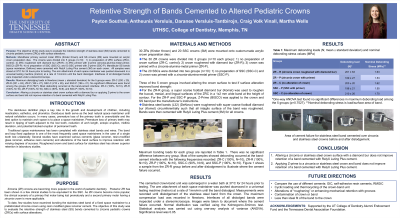Other
209 - Retentive Strength of Bands Cemented to Altered Pediatric Crowns


Payton Southall, DDS
PGY-2 Resident
University of Tennessee, Memphis, TN
University of Tennessee, Memphis, TN
Fairmont, West Virginia, United States- AV
Antheunis Versluis, PhD
UTHSC
- DV
.jpg)
Martha H. Wells, DMD
Chief of Dentistry, Department of Surgery
St. Jude
St. Jude Children's Research Hospital
Memphis, Tennessee, United States- VV
Volk Volk Vinall, DDS, MDS
Program Director
University of Tennessee, Memphis
Memphis, Tennessee, United States
Presenting Author(s)
Co-Author(s)
Research Mentor(s)
Program Director(s)
Purpose: To evaluate bond strength of stainless steel (SS) bands cemented to zirconia pediatric crowns (ZRCs) with surface alterations.
Methods: Lower second mandibular ZRCs (Kinder Krown) and SS crowns (3M) were mounted on acrylic crown preparation dies. The crowns were divided into 5 groups (n=10): 1) no preparation of ZRC surface (ZR-C, control); 2) ZRC roughened with diamond bur (ZR-R); 3) ZRC primed with Z-prime (zirconia-alumina-metal primer, BISCO) (ZR-P); 4) no preparation of SSC (SSC-C); and 5) SSC primed with Z-prime (SSC-P). Mandibular SS bands (space maintainer, DeNovo) were cemented with RelyX Luting Plus cement (3M) on each crown. All samples were stored at 37oC for 24 hours prior to testing. The arm attachment of each space maintainer was pushed downward in a universal testing machine (Instron) at a rate of 1mm/min until the band dislodged. Interfaces of all dislodged bands were inspected under a stereomicroscope.
Results: Maximum dislodging loads in Newtons (mean ± standard deviation) for the 5 groups were: ZR-C (200 ± 20), ZR-R (201 ± 63), ZR-P (189 ± 27), SSC-C (210 ± 26), and SSC-P (196 ± 21).
No significant differences were found among the groups (P=.7527). Most debonding occurred at the band-cement interface: ZR-C (100%, N=10), ZR-R (100%, N=10), ZR-P (100%, N=10), SSC-C (90%, N=9), and SSC-P (100%, N=10).
Conclusions: Altering a zirconia or stainless steel crown surface with a diamond bur or applying Z-prime to the crown surface and band did not improve retention of a band cemented with RelyX Luting Plus.
Identify Supporting Agency and Grant Number:

.jpg)